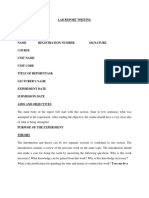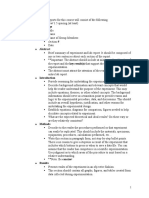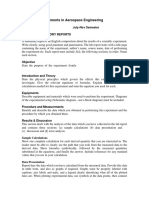0 ratings0% found this document useful (0 votes)
40 viewsLab Report Structure 1. Title Page (As in The Words File Provided)
Lab Report Structure 1. Title Page (As in The Words File Provided)
Uploaded by
almuslimThis document outlines the standard structure for a lab report, including the following sections:
1) Title page with key identifying information.
2) Objective, which briefly describes what the experiment demonstrates and its goals.
3) Data, Observations, and Results, which presents findings in an organized format like a table and analyzes them in relation to expected values. It may include graphs with labeled axes, units, data points, and trend lines.
4) Discussion, which connects results to the objective and addresses sources of error and their effects.
5) Conclusion, which summarizes the report and draws conclusions based on the results and objectives.
Copyright:
© All Rights Reserved
Available Formats
Download as PDF, TXT or read online from Scribd
Lab Report Structure 1. Title Page (As in The Words File Provided)
Lab Report Structure 1. Title Page (As in The Words File Provided)
Uploaded by
almuslim0 ratings0% found this document useful (0 votes)
40 views1 pageThis document outlines the standard structure for a lab report, including the following sections:
1) Title page with key identifying information.
2) Objective, which briefly describes what the experiment demonstrates and its goals.
3) Data, Observations, and Results, which presents findings in an organized format like a table and analyzes them in relation to expected values. It may include graphs with labeled axes, units, data points, and trend lines.
4) Discussion, which connects results to the objective and addresses sources of error and their effects.
5) Conclusion, which summarizes the report and draws conclusions based on the results and objectives.
Original Description:
sample for lab report
Original Title
Lab Report Structure
Copyright
© © All Rights Reserved
Available Formats
PDF, TXT or read online from Scribd
Share this document
Did you find this document useful?
Is this content inappropriate?
This document outlines the standard structure for a lab report, including the following sections:
1) Title page with key identifying information.
2) Objective, which briefly describes what the experiment demonstrates and its goals.
3) Data, Observations, and Results, which presents findings in an organized format like a table and analyzes them in relation to expected values. It may include graphs with labeled axes, units, data points, and trend lines.
4) Discussion, which connects results to the objective and addresses sources of error and their effects.
5) Conclusion, which summarizes the report and draws conclusions based on the results and objectives.
Copyright:
© All Rights Reserved
Available Formats
Download as PDF, TXT or read online from Scribd
Download as pdf or txt
0 ratings0% found this document useful (0 votes)
40 views1 pageLab Report Structure 1. Title Page (As in The Words File Provided)
Lab Report Structure 1. Title Page (As in The Words File Provided)
Uploaded by
almuslimThis document outlines the standard structure for a lab report, including the following sections:
1) Title page with key identifying information.
2) Objective, which briefly describes what the experiment demonstrates and its goals.
3) Data, Observations, and Results, which presents findings in an organized format like a table and analyzes them in relation to expected values. It may include graphs with labeled axes, units, data points, and trend lines.
4) Discussion, which connects results to the objective and addresses sources of error and their effects.
5) Conclusion, which summarizes the report and draws conclusions based on the results and objectives.
Copyright:
© All Rights Reserved
Available Formats
Download as PDF, TXT or read online from Scribd
Download as pdf or txt
You are on page 1of 1
LAB REPORT STRUCTURE
1. Title page (as in the words file provided)
- Title of experiment
- Course number and section
- Day and date experiment was performed and due date
- Authors name
- Names of group members
- Name of lecturer/teaching assistant/lab demonstrator
2. Objective
This should be a brief description of what the experiment is demonstrating. Be specific. It
should be consistent with the statement on the experiment instructions. Some experiments
have one or more parts and each part demonstrates a different aspect. Be sure to include
all objectives of the experiment in this section.
3. Data, Observation and Results
The data and observations obtained in the experiment should be presented in an orderly
form in a data table if possible. A spreadsheet would be ideal, especially if there are
many repetitive calculations in the analysis of the data. Each table, figure and graph
should be labelled and numbered.
The data obtained will be analyzed with a view toward fulfilling the purpose stated at the
beginning of the report. When possible, part of the analysis may be combined with the
data table in a spreadsheet. If there is an accepted or expected value for a quantity that is
to be obtained by the experiment, the percentage difference between the expected and
experimental value should be calculated. In many cases, another part of the analysis will
be the construction of a graph, which is often a very helpful way of showing the
relationship between two quantities.
The graph must have a title, each axis will show scale, units, and a label. All data points
must have a marking to show that it is an observed data point and all data points must be
connected showing the trend of the data. If the student is using a computer software
package to generate graphs, then this package must convey the same information as
would a hand generated graph.
4. Discussion
This section should tie the results of the experiment to the purpose. Sources of error,
deviations and uncertainty should be discussed and how they might affect the results.
Any points that are specifically asked for in experiment instructions should be discussed
in this section.
5. Conclusion
This section summarizes the lab report. Any conclusions drawn from the results should be
given in this section. Express the implication of the results. Examine the outcome in the
light of the stated objectives.
You might also like
- Statistics for Ecologists Using R and Excel: Data Collection, Exploration, Analysis and PresentationFrom EverandStatistics for Ecologists Using R and Excel: Data Collection, Exploration, Analysis and PresentationRating: 3 out of 5 stars3/5 (1)
- CAPE Laboratory Report FormatDocument3 pagesCAPE Laboratory Report FormatReshana Simon100% (1)
- Guide-to-Laboratory-Report-WritingDocument2 pagesGuide-to-Laboratory-Report-Writingephremtaye24No ratings yet
- A Guide To Physics Laboratory Report WritingDocument7 pagesA Guide To Physics Laboratory Report WritingKorir BrianNo ratings yet
- Physics Outline of Lab ReportDocument1 pagePhysics Outline of Lab ReportAnubhav_Kishor_2082No ratings yet
- Lab Report WritingDocument6 pagesLab Report WritingkiokocurtisNo ratings yet
- Lab Reports: Formal Lab Reports For This Course Will Consist of The Following: Format: 12-pt Font, W/ 1.5 Spacing (At Least) o Title PageDocument3 pagesLab Reports: Formal Lab Reports For This Course Will Consist of The Following: Format: 12-pt Font, W/ 1.5 Spacing (At Least) o Title PageAnonymous eJYLPeEo1No ratings yet
- PHYS LAB REPORT FORMATDocument7 pagesPHYS LAB REPORT FORMATchikotibartholomewpatrickNo ratings yet
- List of Mistakes and CommentsDocument12 pagesList of Mistakes and Commentsyaqoob MahNo ratings yet
- MEMB221 Lab ManualDocument66 pagesMEMB221 Lab ManualRynda BlyndaNo ratings yet
- How To Write Lab ReportsDocument5 pagesHow To Write Lab ReportsNourtia NilNo ratings yet
- How To Write A Lab ReportDocument1 pageHow To Write A Lab Reportelsteele100% (1)
- Memd221 Lab Manual Sem 2 2015 2016Document64 pagesMemd221 Lab Manual Sem 2 2015 2016Harith ImranNo ratings yet
- ChE391 Data Analysis Report Marking Scheme F16Document1 pageChE391 Data Analysis Report Marking Scheme F16sirali94No ratings yet
- EPSC 454 - Exploration and Environmental Geophysics Lab Report GuidelinesDocument2 pagesEPSC 454 - Exploration and Environmental Geophysics Lab Report GuidelinesMissyNo ratings yet
- Research Plan Format For Engineering Design ProjectsDocument5 pagesResearch Plan Format For Engineering Design ProjectsAnton Colasi CorulloNo ratings yet
- Laboratory Reports For Instrumental Analysis: PackagingDocument4 pagesLaboratory Reports For Instrumental Analysis: PackagingxregisterNo ratings yet
- Experiment Project Report LayoutDocument2 pagesExperiment Project Report LayoutKendra KaiserNo ratings yet
- Title Page: - Motivation - Scope - Approach - % ErrorDocument6 pagesTitle Page: - Motivation - Scope - Approach - % ErrorjohnNo ratings yet
- 01 How To Write An IB Science Lab ReportDocument5 pages01 How To Write An IB Science Lab ReportWisaruth MaethasithNo ratings yet
- Laboratory 01 - ES TemplateDocument3 pagesLaboratory 01 - ES TemplateNoreen BoncalesNo ratings yet
- Format of Laboratory ReportDocument2 pagesFormat of Laboratory Reportatharvk.ecell.iitbNo ratings yet
- Biology Lab Report FormatDocument5 pagesBiology Lab Report FormatAnastasiaNo ratings yet
- General Format: 2. Useful Reminders For Each SectionDocument4 pagesGeneral Format: 2. Useful Reminders For Each SectionJon JonNo ratings yet
- How To Make An Investigatory ProjectDocument2 pagesHow To Make An Investigatory ProjectCecille TagayNo ratings yet
- Class Project Local GeochemistDocument5 pagesClass Project Local Geochemistsalimshahzad31No ratings yet
- Laboratory Report Guidelines JKUAT UndergraduateDocument3 pagesLaboratory Report Guidelines JKUAT UndergraduateDECENT DECENT MUSINAINo ratings yet
- Laboratory Report Format: What and Why How What You Found What It MeansDocument4 pagesLaboratory Report Format: What and Why How What You Found What It MeansSophia NuelleNo ratings yet
- Machine Design and CAD Lab ManualDocument45 pagesMachine Design and CAD Lab ManualPraviin Jayakumar100% (3)
- Lab Manual Mechanic of Materials SEM 2 20132014Document65 pagesLab Manual Mechanic of Materials SEM 2 20132014saruwatari michiyo100% (1)
- Lab Report Guidelines Re HagenDocument19 pagesLab Report Guidelines Re Hagenmays.meso12.mNo ratings yet
- Lab Report Guidelines Re HagenDocument19 pagesLab Report Guidelines Re Hagenmays.meso12.mNo ratings yet
- Lab Report Guidelines RehagenDocument19 pagesLab Report Guidelines Rehagenzlmulaudzi42No ratings yet
- Laboratory Report FormatDocument4 pagesLaboratory Report FormatthienmakbNo ratings yet
- Simple Physics Lab School ReportDocument9 pagesSimple Physics Lab School ReportAnne ZOUNo ratings yet
- 1112 HL Chem Lab Report Format - Design FocusDocument3 pages1112 HL Chem Lab Report Format - Design FocusChirag HablaniNo ratings yet
- Lab Report FormattingDocument4 pagesLab Report Formattingmonaxe.from.xboxNo ratings yet
- Air Resistance LabDocument1 pageAir Resistance LabEthan MedleyNo ratings yet
- LabrepDocument1 pageLabrepKevinNo ratings yet
- 5-Lab Report FormatDocument1 page5-Lab Report FormatcoleiroNo ratings yet
- A451 Lab Reports GuidelinesDocument2 pagesA451 Lab Reports GuidelinesKeshav Kant100% (1)
- Log Record (Individual) : Do Not Copy From Lab ManualDocument1 pageLog Record (Individual) : Do Not Copy From Lab ManualNur Musfirah MuslimNo ratings yet
- Fluid Mechanics Lab ManualDocument16 pagesFluid Mechanics Lab ManualnidhalsaadaNo ratings yet
- Basic Guide To Lab ReportDocument18 pagesBasic Guide To Lab Reporteskandar.kiryakosNo ratings yet
- Report Writing GuidelinesF17Document8 pagesReport Writing GuidelinesF17humaboutNo ratings yet
- Laboratory Report WritingDocument3 pagesLaboratory Report Writingmaxwellkarani89No ratings yet
- Guidance For Writing Lab ReportsDocument31 pagesGuidance For Writing Lab ReportsMehdi Chames Eddinne LAYESNo ratings yet
- IB IA Lab Template 2016Document4 pagesIB IA Lab Template 2016ayseNo ratings yet
- Report Writing GuidelinesDocument4 pagesReport Writing GuidelinesMais MuallaNo ratings yet
- Format of Lab ReportsDocument1 pageFormat of Lab Reportsalibaba011No ratings yet
- Lab Report GuidelinesDocument2 pagesLab Report GuidelinesAdel Al-EnaziNo ratings yet
- CAPSTONE Assessment - Laboratory ReportDocument6 pagesCAPSTONE Assessment - Laboratory ReportAngela D.No ratings yet
- PRE2Document3 pagesPRE2Tina SinghNo ratings yet
- Engineering 12 SPRING 2008 Physical Systems Analysis I Page 1/3 Formal Laboratory Report FormatDocument3 pagesEngineering 12 SPRING 2008 Physical Systems Analysis I Page 1/3 Formal Laboratory Report FormatAllyssa SenerpidaNo ratings yet
- AP Bio Lab Report ProceduresDocument2 pagesAP Bio Lab Report Proceduresnorahedwards7No ratings yet
- 155 Laboratory Syllabus 2015Document16 pages155 Laboratory Syllabus 2015Nguyen Viet HungNo ratings yet
- Guidance For Writing Lab ReportsDocument31 pagesGuidance For Writing Lab Reportsalawi1889No ratings yet
- Lab Format OutlineDocument4 pagesLab Format Outlinecharmdoodle6965No ratings yet



























































